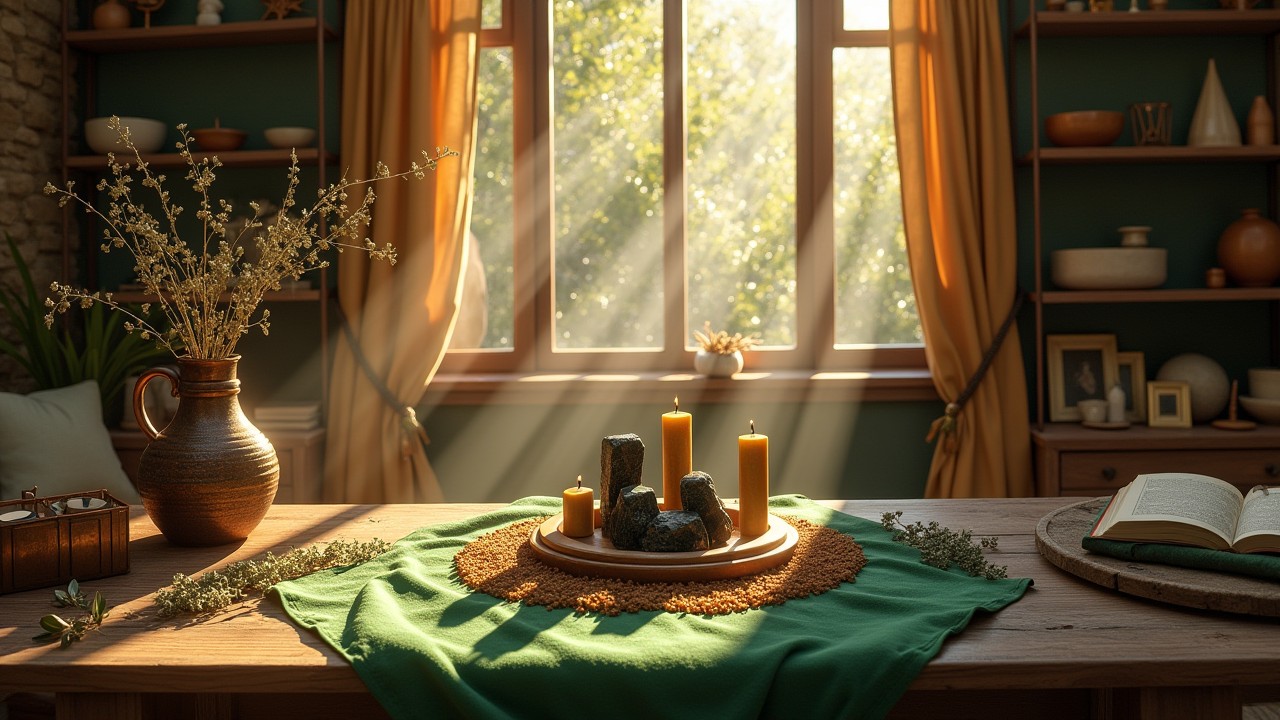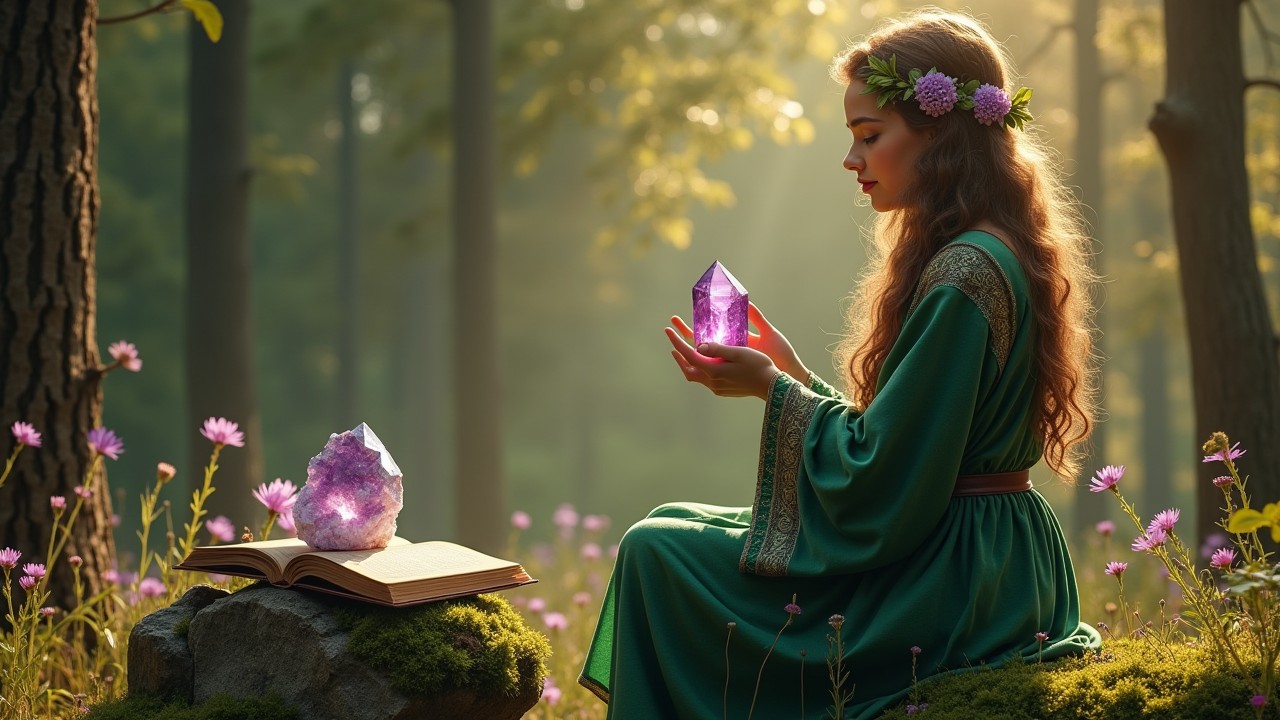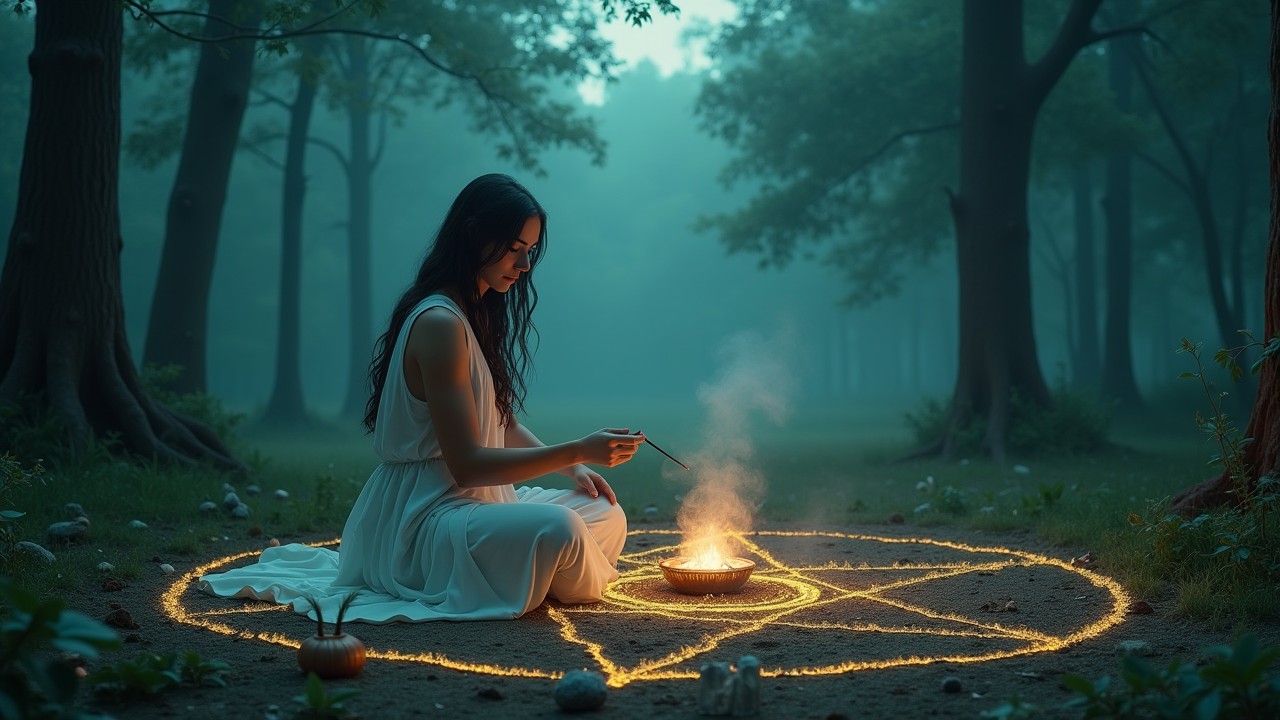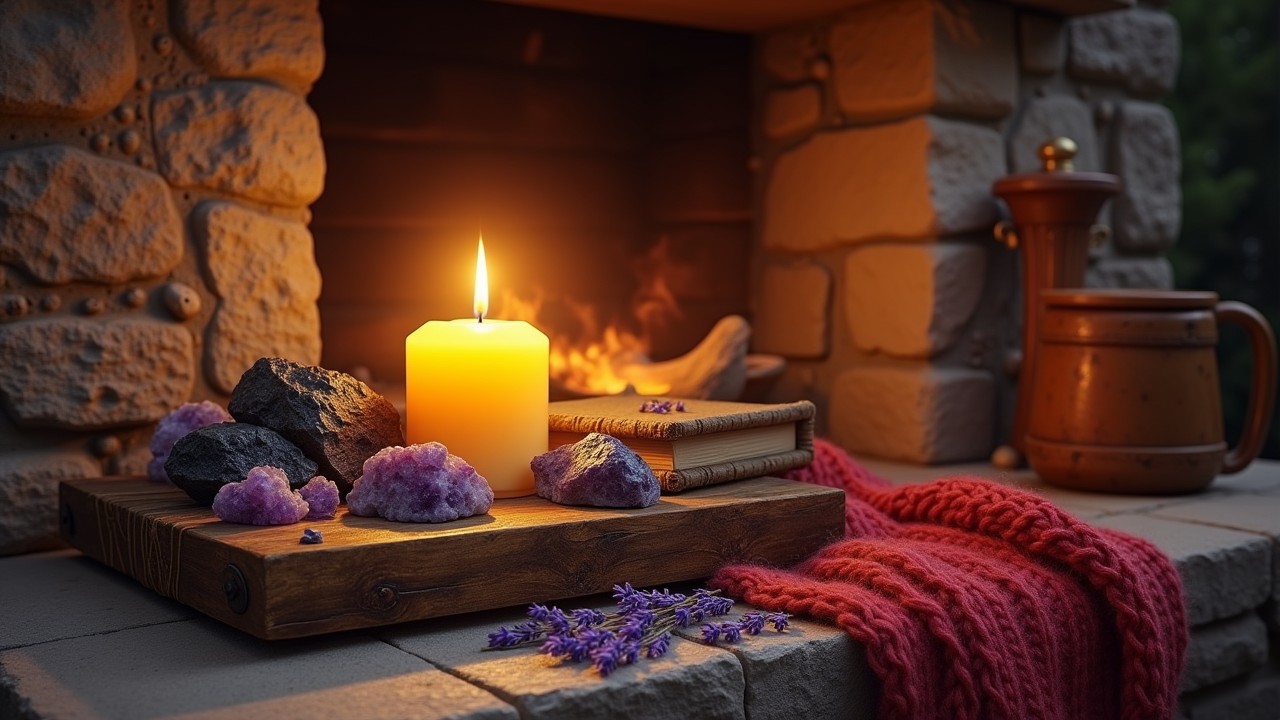Imagine standing in a mist-shrouded forest where ancient oak trees whisper stories older than written history, where every stream holds the spirit of a goddess and every hill conceals the burial mound of a forgotten king-god. Picture a world where the boundary between the mortal realm and the divine is as thin as morning fog, where gods and goddesses walk among mortals, fall in love with them, wage wars alongside them, and shape the very landscape through their actions and emotions. This is the world of Celtic mythology, a rich tapestry of divine beings who represent not distant, untouchable deities, but forces of nature and aspects of human experience so immediate and real that they could step from the Otherworld into your backyard at any moment.
Understanding Celtic mythology requires a fundamentally different approach from studying more familiar pantheons like those of Greece or Rome. While Greek gods live on Mount Olympus and Roman deities reside in structured temples, Celtic gods and goddesses inhabit the landscape itself—dwelling in rivers and mountains, sacred groves and ancient burial mounds, existing in a realm called the Otherworld that constantly intersects with our own. Think of Celtic mythology not as a collection of stories about distant supernatural beings, but as a way of seeing the world where every element of nature pulses with divine consciousness and every significant event in human life reflects the ongoing drama of the gods.
This approach to understanding the divine shapes everything about Celtic mythology, from how these deities behave to how their stories function to how people related to them in daily life. Rather than learning about gods who rule specific domains from celestial thrones, you’ll discover divine beings who are intimately connected to particular places, seasons, and human experiences. Celtic gods and goddesses don’t just control aspects of life—they embody them, live them, and evolve through them in ways that make their stories feel vibrantly alive even thousands of years after they were first told around firelit gatherings in ancient Ireland, Wales, Scotland, and Gaul.
Understanding the Foundation: What Makes Celtic Mythology Unique
Before we can meaningfully explore individual Celtic deities, we need to build a solid foundation for understanding how Celtic mythology works as a spiritual and cultural system. This foundation will help you appreciate why Celtic gods and goddesses behave so differently from other mythological figures and why their stories often seem more complex and interconnected than the more linear narratives we might expect from other traditions.
Celtic mythology encompasses the beliefs and stories of various Celtic peoples who inhabited much of Europe for over a thousand years, including the areas we now know as Ireland, Scotland, Wales, Cornwall, Brittany, and parts of England, France, Spain, and even central Europe. However, these weren’t unified peoples with a single set of beliefs, but rather related tribal groups who shared similar languages, customs, and worldviews while maintaining distinct regional traditions and variations in their mythology.
This diversity creates both richness and complexity when studying Celtic deities. Unlike Greek mythology, which was eventually standardized through written literature, or Roman mythology, which was systematically organized for state religious purposes, Celtic mythology remained largely oral until Christian scribes began recording it centuries after the original cultures had been disrupted by Roman conquest and Christian conversion. Think of studying Celtic mythology like assembling a vast, beautiful puzzle where many pieces are missing, some pieces come from different versions of the same picture, and the original artists never intended to create a single, unified image in the first place.
The oral tradition that preserved Celtic mythology for centuries also shaped how these stories function and what they emphasize. Oral storytelling prioritizes memorable characters, dramatic conflicts, and emotionally resonant themes rather than systematic theology or consistent divine hierarchies. This means that Celtic gods and goddesses often appear in multiple, sometimes contradictory versions of stories, may have different names in different regions, and might fulfill varying roles depending on what particular story is being told and what lesson or entertainment value the storyteller wants to emphasize.
The Celtic understanding of divinity itself differs significantly from other mythological systems in ways that make their gods and goddesses particularly complex and multifaceted. Celtic deities rarely embody single, clearly defined domains like war or love or wisdom. Instead, they tend to represent multiple, interconnected aspects of existence, often combining seemingly contradictory qualities like creation and destruction, healing and harm, wisdom and wildness. This complexity reflects the Celtic understanding that life itself is complex and that divine forces, like natural forces, cannot be easily categorized or controlled.
The concept of the Otherworld provides perhaps the most important key to understanding Celtic mythology and its deities. The Otherworld—known by various names including Tír na nÓg, the Land of the Young, and Annwn—represents a parallel realm that coexists with our physical world but operates according to different rules of time, space, and possibility. Think of the Otherworld not as a distant heaven or underworld, but as an alternate dimension that constantly intersects with ordinary reality, accessible through certain places, times, and states of consciousness.
Celtic gods and goddesses move freely between the Otherworld and the mortal realm, appearing in both supernatural and human forms, intervening in human affairs, and forming relationships with mortals that can span generations. This fluidity between worlds means that Celtic deities are simultaneously transcendent divine beings and immediate, personal presences who can be encountered in dreams, during ritual activities, or even in everyday life when conditions are right.
The landscape itself functions as a living text in Celtic mythology, with geographical features serving as repositories of divine presence and mythological memory. Sacred sites like ancient burial mounds, natural springs, and stone circles aren’t just places where gods and goddesses were once worshipped—they’re locations where these deities continue to reside and can still be approached by those who understand how to do so respectfully and appropriately.
The Tuatha Dé Danann: The Foundation of Irish Divine Society
To understand Celtic mythology as a coherent system, we must begin with the Tuatha Dé Danann, the supernatural race that forms the core of Irish mythological tradition and provides the clearest picture we have of how Celtic peoples envisioned divine society and cosmic order. The name Tuatha Dé Danann translates as “People of the Goddess Danu,” and these beings represent the primary gods and goddesses of Irish Celtic tradition, functioning both as individual deities with specific powers and domains and as a unified divine community with complex family relationships and shared history.
Think of the Tuatha Dé Danann as a divine family or tribe whose members embody different aspects of cosmic and social order while maintaining the kinds of complex, sometimes difficult relationships that characterize any large, powerful family. These aren’t remote, perfect beings who exist in sublime harmony, but passionate, dynamic individuals whose conflicts, alliances, love affairs, and power struggles provide the dramatic tension that drives much of Irish mythology while illustrating important truths about how divine forces operate in the world.
The Tuatha Dé Danann entered Irish mythology as invaders who arrived from the Otherworld to claim Ireland from its previous inhabitants, the Fir Bolg, through a series of magical battles that established their right to rule the island. However, their sovereignty was immediately challenged by another supernatural race, the Fomorians, who represented older, more chaotic forces associated with the sea, darkness, and primordial wildness. The conflict between these two groups provides the central organizing narrative for understanding how cosmic order emerges from primordial chaos in Celtic mythology.
This foundational story teaches us several crucial things about how Celtic mythology functions. First, it shows us that divine power isn’t static or uncontested—it must be won, maintained, and defended through ongoing struggle. Second, it reveals that order and chaos aren’t absolute opposites but complementary forces that must remain in dynamic balance for the world to function properly. Third, it demonstrates that the gods themselves are subject to change, loss, and the need for renewal, making them more complex and psychologically realistic than deities who remain forever unchanged.
After establishing their rule through the defeat of the Fomorians, the Tuatha Dé Danann themselves eventually withdrew from direct rule of Ireland when mortal humans—the ancestors of the historical Irish people—arrived to claim the island. Rather than being destroyed or exiled, the Tuatha Dé Danann negotiated a peaceful transition that allowed them to retain sovereignty over the Otherworld and the inner dimensions of Irish landscape while granting surface rule to human beings. This arrangement explains how divine presences continue to inhabit Ireland through sacred sites, seasonal celebrations, and ongoing relationships with human beings who know how to maintain proper connections with the Otherworld.
Understanding this mythological framework helps us appreciate why Celtic deities often appear in stories not as remote powers who must be appeased through formal worship, but as potential allies, mentors, lovers, or adversaries whose ongoing relationships with mortals shape both individual destinies and collective cultural development. The gods and goddesses of the Tuatha Dé Danann aren’t just objects of religious devotion—they’re participants in an ongoing cosmic drama in which human beings play essential roles.
The family relationships within the Tuatha Dé Danann also provide important insights into how Celtic peoples understood the connections between different aspects of divine power. Rather than organizing deities into functional categories like war gods, love goddesses, and wisdom deities, Celtic mythology tends to show us how different divine qualities emerge from common sources and remain interconnected through family bonds, shared experiences, and mutual obligations that prevent any single divine power from operating in isolation.
Danu: The Great Mother and Source of Divine Power
At the heart of Irish Celtic mythology stands Danu, the great mother goddess whose name provides the foundation for understanding not just the Tuatha Dé Danann but the entire Celtic conception of how divine power originates and flows through the world. Danu represents the primordial feminine creative force from which all other divine beings emerge, yet she remains one of the most mysterious figures in Celtic mythology, rarely appearing as an active character in stories while maintaining an essential presence as the source and sustainer of all divine activity.
Think of Danu like the deep underground aquifer that feeds all the rivers, springs, and wells in a region—her presence makes everything else possible, but she herself remains largely hidden from direct observation, known primarily through her effects and through the vitality of everything that draws life from her power. This hidden-yet-essential quality characterizes many of the most important divine figures in Celtic mythology, reflecting the Celtic understanding that the most powerful forces in the universe often work through subtle influence rather than dramatic display.
The name Danu appears to be related to ancient Indo-European words meaning “flowing water,” connecting her to the life-giving properties of rivers and streams while also suggesting the flowing, dynamic nature of divine creative energy itself. Some scholars believe that Danu may be connected to the River Danube, which was named for a similar goddess figure, and to other river goddesses throughout the Celtic world, suggesting that her influence extended far beyond Ireland to encompass a general principle of feminine divine creativity recognized across Celtic cultures.
In Irish tradition, Danu is often identified or closely associated with Anu, another mother goddess figure who is explicitly called “the mother of the Irish gods” in medieval Irish texts. The relationship between these two figures illustrates how Celtic mythology often preserves multiple versions or aspects of the same essential divine principle, allowing for regional variations and different ways of understanding the same fundamental spiritual truth. Whether you think of her as Danu or Anu or simply as the Great Mother, this figure represents the fertile, creative, life-sustaining aspect of divine feminine power that gives birth to and nurtures all other forms of consciousness and existence.
Danu’s role as mother of the gods doesn’t mean that she literally gave birth to every member of the Tuatha Dé Danann in the way that human mothers bear children. Instead, she represents the cosmic principle from which divine consciousness emerges and to which it remains connected throughout all its subsequent developments and expressions. Her children inherit not just magical powers and immortal life, but also her wisdom, her creative abilities, and her deep connection to the land and its cycles of growth, harvest, death, and renewal.
The relative absence of detailed stories about Danu herself reflects the Celtic understanding that the most fundamental divine powers work through influence and presence rather than through dramatic action. She doesn’t need to appear as a character in myths because her presence permeates every story told about her divine children. Every act of healing performed by Brigid, every victory won by Lugh, every feast hosted by the Dagda reflects and honors the creative power that flows from Danu’s essential nature.
This understanding of Danu provides a crucial key to appreciating how Celtic mythology differs from other mythological systems that feature more prominent mother goddess figures. Rather than being a distinct personality who competes with other deities for attention and worship, Danu represents the source from which all divine personalities emerge while remaining fundamentally connected to that source. Her children don’t rebel against her or seek to overthrow her authority because doing so would mean cutting themselves off from the very source of their own power and existence.
Modern practitioners who work with Celtic deities often find that developing a relationship with Danu provides a foundation for understanding and connecting with all other Celtic divine figures. She represents the deep wellspring of Celtic spiritual wisdom and power, the mother tongue from which all other Celtic divine languages develop, the root system that nourishes all the diverse flowers and fruits of Celtic mythology and spirituality.
The Dagda: The Good God and Divine Father Figure
Among the most beloved and accessible figures in Irish mythology stands the Dagda, whose name means “the Good God”—not good in the sense of moral perfection, but good in the sense of being good at everything he attempts, multi-talented, generous, and fundamentally reliable in ways that make him both an effective leader and a protective father figure for divine and mortal communities alike. The Dagda embodies the ideal of competent, benevolent masculine authority that protects and provides for others while maintaining the wisdom, humor, and humility that prevent power from becoming tyrannical or destructive.
Picture the Dagda as the village chieftain who can repair a broken cart wheel, mediate a dispute between neighbors, tell stories that make children laugh, organize a successful harvest feast, and defend the community from raiders—all while maintaining the kind of earthy humor and unpretentious manner that makes everyone feel comfortable approaching him for help or advice. This combination of practical competence, protective strength, and emotional accessibility makes the Dagda one of the most psychologically realistic and humanly relatable figures in Celtic mythology.
The Dagda’s magical possessions reflect his role as the divine provider and protector whose powers ensure abundance, protection, and renewal for those under his care. His great club or staff can kill enemies with one end and restore life with the other, representing his authority over both death and rebirth, destruction and renewal, the necessary clearing away of what has become harmful and the restoration of what serves life and growth. This dual-natured weapon teaches us that true divine authority must be capable of both setting boundaries and nurturing growth, both defending against threats and creating conditions for flourishing.
His magical cauldron, which can provide inexhaustible nourishment for any number of people, represents the principle of divine abundance that ensures no one under proper divine protection need suffer from want or scarcity. However, the cauldron doesn’t work automatically—it responds to the Dagda’s wisdom and generosity, providing abundance when it serves the greater good while remaining empty when approached with selfish or destructive intentions. This magical vessel teaches us that divine abundance flows most freely when it’s shared rather than hoarded and when it serves community wellbeing rather than individual accumulation.
The Dagda’s role as a lover and father figures prominently in many stories, illustrating how divine masculine energy expresses itself through relationship, creativity, and the nurturing of new life rather than through domination or competition. His relationships with various goddesses produce children who become major divine figures in their own right, including Brigid, the beloved goddess of smithcraft, poetry, and healing. These relationships show us that divine masculine and feminine energies work together creatively rather than in opposition, each contributing essential qualities to the development of cosmic and social order.
Stories about the Dagda often emphasize his earthiness, his enormous appetite, his sometimes crude humor, and his unpretentious approach to even the most serious divine responsibilities. Rather than diminishing his dignity, these human-like qualities make him more accessible and trustworthy to people who must deal with the practical challenges of daily life. The Dagda understands hunger, fatigue, the need for comfort and pleasure, and the importance of laughter in maintaining psychological health during difficult times.
The Dagda’s leadership of the Tuatha Dé Danann demonstrates Celtic ideals of authority based on competence, wisdom, and service rather than on dominance or inherited privilege. He becomes king not because he demands obedience, but because others recognize his ability to make decisions that benefit the entire community while protecting the vulnerable and maintaining justice. His authority comes from his willingness to take responsibility for others’ wellbeing rather than from any claim to special status or privilege.
In battle, the Dagda fights with strategic wisdom and protective courage rather than with the bloodthirsty enthusiasm that characterizes some war deities in other traditions. He engages in combat to defend his people and maintain cosmic order, not to satisfy personal ambition or to prove his strength. This approach to divine warfare reflects Celtic values that honored courage and martial skill while emphasizing that true strength serves protection and justice rather than conquest and domination.
The Dagda’s humor and humanity make him particularly accessible to modern practitioners who seek divine guidance and support in dealing with practical challenges and everyday responsibilities. He represents the kind of divine masculine energy that strengthens rather than diminishes others, that leads through example rather than through intimidation, and that maintains connection to earthly pleasures and human needs while exercising cosmic authority and spiritual wisdom.
Brigid: The Threefold Goddess of Inspiration and Craft
Brigid stands among the most beloved and widely honored figures in Celtic mythology, representing the divine feminine principle of creative inspiration, skillful craftsmanship, and healing wisdom that transforms raw materials into objects of beauty, utility, and power. As both a member of the Tuatha Dé Danann and the goddess who bridges ancient Pagan tradition with Christian devotion, Brigid demonstrates how essential spiritual principles transcend specific religious forms while maintaining their fundamental power to inspire, heal, and guide human development.
Think of Brigid as the divine patroness of everyone who transforms raw potential into realized creation—whether they’re smiths working metal into tools and weapons, poets crafting words into verses that capture truth and beauty, healers applying knowledge to restore health and wellbeing, or simply individuals learning to develop their natural talents into skills that serve both personal fulfillment and community benefit. Her presence blesses and guides any work that involves bringing something new and valuable into existence through the application of skill, wisdom, and inspired creativity.
The threefold nature of Brigid’s power reflects the Celtic understanding that creation involves multiple types of skill and knowledge working together harmoniously. As the goddess of smithcraft, she governs the manipulation of fire and metal to create tools, weapons, and objects of beauty that serve human needs while demonstrating the craftsperson’s skill and artistic vision. As the goddess of poetry and learning, she inspires the manipulation of language, rhythm, and imagery to create verses that preserve cultural wisdom, celebrate important events, and provide entertainment and emotional expression. As the goddess of healing, she guides the application of herbal knowledge, intuitive wisdom, and compassionate care to restore health and ease suffering.
These three aspects of Brigid’s power aren’t separate functions but interconnected expressions of the same essential creative principle. All three involve working with natural materials—metal, words, healing plants—and transforming them through skill, knowledge, and inspired creativity into something that serves human needs more effectively than the raw materials could serve on their own. All three require both technical competence and creative vision, both practical knowledge and intuitive wisdom, both individual skill and concern for community wellbeing.
Brigid’s association with fire provides a crucial key to understanding her essential nature and her role in both cosmic and human affairs. Fire represents the principle of transformation that makes all creative work possible—the forge fire that makes metal malleable, the inner fire of inspiration that illuminates poets and healers, the vital fire of life energy that sustains health and enables growth and renewal. Brigid doesn’t just use fire; she embodies the transformative principle that fire represents, the divine spark that enables consciousness to reshape matter according to vision and intention.
The seasonal celebration of Imbolc, held at the beginning of February, honors Brigid’s role in the annual cycle of death and renewal by marking the first stirrings of spring energy after winter’s dormancy. At Imbolc, daylight begins to noticeably lengthen, domestic animals begin producing milk again, and the first early flowers appear despite cold weather, demonstrating that the creative life force is stirring even when surface conditions still appear barren. This festival teaches us that Brigid’s creative energy works like the warming earth in late winter—quietly preparing for dramatic growth and renewal that will become visible only when the proper time arrives.
Brigid’s later transformation into Saint Brigid of Kildare illustrates how essential spiritual principles can transition between different religious systems while maintaining their fundamental power and relevance. The Christian Saint Brigid retained many of the same associations with fire, inspiration, healing, and protection that characterized the Pagan goddess, while adding specifically Christian virtues like charity, humility, and devotion to divine service. This transition suggests that Brigid represents spiritual qualities so fundamental to human experience that they remain relevant regardless of specific theological frameworks or cultural contexts.
Many modern practitioners find that working with Brigid provides particularly accessible and practical guidance for developing creative abilities, healing skills, and spiritual inspiration in ways that serve both personal growth and community benefit. She represents the divine feminine principle that encourages excellence and creativity rather than demanding perfection or self-sacrifice, that celebrates human potential while providing patient guidance for developing that potential through practice, study, and dedication to craft.
Brigid’s guidance often comes through inspiration, sudden insights, creative breakthroughs, and the gradual development of skill and wisdom through dedicated practice rather than through dramatic supernatural intervention. Those who honor her typically find that their creative work becomes more inspired and effective, their healing abilities develop greater sensitivity and power, and their overall approach to life becomes more creative, resourceful, and attuned to opportunities for growth and service.
Lugh: The Master of All Skills and Divine Perfection
Lugh represents perhaps the most complex and fascinating figure in Celtic mythology, embodying the principle of excellent skill and accomplished mastery that enables individuals to excel in multiple areas while using their abilities to serve greater purposes than personal advancement alone. Known as the master of all arts and skills, Lugh demonstrates how divine consciousness expresses itself through the pursuit of excellence and the integration of diverse abilities into coherent wisdom that serves both individual fulfillment and cosmic order.
Picture Lugh as the individual who excels at everything he attempts—warrior, craftsman, musician, poet, athlete, strategist, diplomat—but who uses his extraordinary abilities not to dominate others or accumulate power for its own sake, but to protect the vulnerable, maintain justice, defeat chaos and ignorance, and demonstrate what becomes possible when human potential is fully realized and properly directed. His perfection doesn’t intimidate or diminish others but rather inspires them to develop their own abilities more fully while showing them what excellence looks like when it serves wisdom rather than ego.
The story of Lugh’s arrival at the court of the Tuatha Dé Danann perfectly illustrates his essential nature and his role in Celtic mythology. When Lugh approaches the royal hall and requests admission, the gatekeeper asks what skills he possesses, since no one may enter unless they can contribute something valuable to the divine community. Lugh lists his abilities—he is a craftsman, a warrior, a harpist, a poet, a sorcerer, a physician, a cupbearer, and a brazier. The gatekeeper responds that they already have experts in each of these areas, so Lugh need not enter. Lugh then asks whether they have anyone who excels in all these skills simultaneously, and when the gatekeeper admits they do not, Lugh is admitted and quickly becomes indispensable to the divine community.
This story teaches us several important lessons about how excellence functions in Celtic understanding. First, it shows us that true mastery involves not just developing a single skill to perfection, but integrating multiple abilities in ways that create something greater than the sum of its parts. Second, it demonstrates that excellence serves its highest purpose when it contributes to community wellbeing rather than just personal advancement. Third, it illustrates that divine consciousness expresses itself through the complete development of potential rather than through the limitation or suppression of natural abilities.
Lugh’s role in the great battle against the Fomorians provides another crucial key to understanding his mythological significance. When the forces of chaos and destruction threaten to overwhelm cosmic order, Lugh’s integrated skills and strategic wisdom enable the Tuatha Dé Danann to achieve victory through superior planning, coordination, and execution rather than through brute force alone. His leadership demonstrates how excellence in multiple areas creates the flexibility and adaptability necessary for dealing with complex challenges that require various types of knowledge and skill working together effectively.
The seasonal festival of Lughnasadh, celebrated at the beginning of August, honors Lugh’s role in ensuring successful harvests through his association with the skills needed for agriculture, craftsmanship, and community organization. This festival celebrates not just the gathering of crops, but the application of human knowledge and skill to ensure that natural abundance serves human needs through proper planning, timing, and technique. Lughnasadh reminds us that abundance doesn’t just happen automatically but results from the intelligent application of diverse skills working together toward common goals.
Lugh’s weapons and magical possessions reflect his mastery of different types of power and his ability to choose the most appropriate tool or technique for each specific situation. His spear never misses its target and always returns to his hand, representing perfect aim and focus guided by wisdom rather than anger or hatred. His sword can cut through any defense, representing the power of truth and justice to overcome deception and corruption. His silver arm, acquired after losing his original arm in battle, represents the ability to continue functioning effectively even after experiencing loss or injury.
Many modern practitioners find that working with Lugh provides inspiration and guidance for developing their own diverse abilities while maintaining focus on service and excellence rather than becoming scattered or competitive. He represents the divine masculine principle that seeks mastery through dedication and practice rather than through domination of others, that uses skill and knowledge to solve problems and create value rather than to accumulate power or status.
Lugh’s influence often manifests through increased motivation to develop skills, clearer perception of how different abilities can work together effectively, and opportunities to use developing talents in service of meaningful goals. Those who honor him typically find that their various interests and abilities begin to integrate in ways that create new possibilities for creative expression, problem-solving, and community contribution.
The Morrigan: The Prophetic Goddess of War and Fate
The Morrigan stands as one of the most complex and misunderstood figures in Celtic mythology, representing not simply a goddess of war and death, but the divine feminine principle that perceives and proclaims truth about fate, transformation, and the necessary cycles of destruction and renewal that maintain cosmic balance. Often appearing as a trilogy of sister goddesses or as a single figure with three aspects, the Morrigan embodies the terrifying but essential wisdom that sees clearly what must be faced, changed, or released for growth and renewal to become possible.
Think of the Morrigan as the wise woman who tells you truths you don’t want to hear but desperately need to understand—the mother who points out that your relationship has become toxic, the mentor who explains that your current career path won’t lead where you want to go, the friend who helps you see that your patterns of behavior are creating the problems you keep complaining about. Her message is rarely comfortable, but it’s always necessary for anyone who wants to live authentically and develop their full potential rather than remaining trapped in illusions, denial, or patterns that no longer serve growth.
The Morrigan’s association with battlefields doesn’t mean she delights in violence for its own sake, but rather that she appears wherever fundamental conflicts between opposing forces create opportunities for truth to emerge and transformation to occur. War, in Celtic understanding, represents not just physical combat but any situation where incompatible forces clash in ways that force clarity about what can and cannot continue. The Morrigan appears at these moments to ensure that the outcome serves justice and cosmic balance rather than merely rewarding the strongest or most ruthless participants.
Her ability to shape-shift, particularly into the form of a crow or raven, reflects her role as a messenger between different realms of existence and different levels of consciousness. Crows and ravens are intelligent, adaptable birds that thrive in many environments while serving as scavengers who clean up carrion and waste, transforming death into renewed life through natural processes. The Morrigan’s crow form allows her to move freely between the world of the living and the realm of the dead, gathering information about both past and future events while serving the cosmic function of clearing away what has died so that new life can emerge.
The prophetic aspect of the Morrigan’s power provides perhaps the most important key to understanding her role in Celtic mythology and her continuing relevance for modern practitioners. She doesn’t predict the future in the sense of revealing fixed, unchangeable destiny, but rather perceives the natural consequences of current choices and actions while revealing what changes would be necessary to create different outcomes. Her prophecies serve as warnings and guidance rather than as statements of unchangeable fate.
The relationship between the Morrigan and various male heroes in Celtic mythology, particularly her interactions with Cú Chulainn, illustrates how her harsh wisdom serves development and growth even when it’s rejected or resisted. She appears to heroes at crucial moments offering alliance, guidance, or warning, and their response to her determines whether they achieve their full potential or fall victim to their own limitations and blindness. Those who accept her difficult wisdom gain the strength and clarity needed for true heroism, while those who reject her guidance typically discover that avoiding uncomfortable truths leads to tragedy and failure.
The Morrigan’s triple nature—whether understood as three sister goddesses or as one goddess with three aspects—represents the complete scope of her wisdom about fate, transformation, and the cycles of existence. She perceives what was, what is, and what will be, understanding how past actions create present circumstances and how current choices shape future possibilities. This comprehensive vision enables her to provide guidance that takes into account not just immediate concerns but long-term consequences and the broader patterns that govern individual and collective development.
Many modern practitioners find that working with the Morrigan requires courage, honesty, and willingness to face uncomfortable truths about themselves and their circumstances. She doesn’t offer comfort or reassurance, but she provides the clarity and strength needed for making necessary changes and accepting responsibility for creating more authentic and empowered ways of living. Her guidance often comes through dreams, synchronicities, and sudden insights that illuminate patterns or possibilities that had been hidden by wishful thinking or fear.
The Morrigan’s protection comes not through shielding people from challenges or difficulties, but through strengthening their ability to face whatever must be faced while maintaining their integrity and wisdom. Those who honor her typically find that they develop greater resilience, clearer perception of truth and illusion, and increased ability to navigate complex situations with wisdom and strength rather than being overwhelmed by uncertainty or fear.
Manannan mac Lir: The Guide Between Worlds
Manannan mac Lir, whose name means “son of the sea,” serves as perhaps the most important guide and mediator between the ordinary world and the Otherworld in Celtic mythology, representing the divine principle that facilitates travel, communication, and exchange between different realms of existence while protecting travelers and maintaining the boundaries that prevent chaos from overwhelming order. As a sea god and ruler of the Otherworld island of Tír na nÓg, Manannan embodies the wisdom needed for navigating between different states of consciousness, different phases of life, and different levels of spiritual reality.
Picture Manannan as the wise ferryman who knows all the hidden paths between islands, who understands the tides and currents that can either help or hinder your journey, who can provide you with the magical tools and knowledge you need for safe passage through dangerous waters, but who also maintains strict protocols about who may travel where and when such journeys serve appropriate purposes rather than mere curiosity or escapism. His guidance makes profound spiritual experiences possible while ensuring that such experiences contribute to growth and wisdom rather than leading to imbalance or illusion.
The sea itself provides the perfect metaphor for understanding Manannan’s essential nature and his role in Celtic spiritual cosmology. The ocean connects all lands while remaining distinct from any particular place, changes constantly while maintaining essential continuity, appears placid on the surface while concealing tremendous depth and power, and serves as both a highway for travel and communication and a barrier that protects different regions from unwanted intrusion. Manannan embodies all these qualities of the sea while applying them to the task of facilitating appropriate communication and travel between the physical world and spiritual realms.
Manannan’s magical possessions reflect his mastery of travel, communication, and the transformation that occurs when consciousness moves between different levels of reality. His boat, which can travel over both water and land without sails or oars, represents the ability to navigate spiritual realms through will, intention, and knowledge rather than through physical effort or ordinary logical understanding. His cloak of mist, which can conceal entire islands from unwanted visitors, represents the protection that surrounds sacred places and spiritual experiences, ensuring that they remain accessible to those who approach with proper preparation and intention while remaining hidden from those who might exploit or corrupt them.
His pigs, which can be slaughtered for food and return to life the next day, represent the renewable resources available in the Otherworld and the principle that spiritual nourishment doesn’t diminish through sharing but rather increases when it serves genuine need and development. His horses, which can travel across both sea and land, represent the vehicles of consciousness that enable travel between different states of awareness when guided by wisdom and appropriate intention.
The role of Manannan as foster father to many heroes and divine figures in Celtic mythology illustrates his function as the guide who provides essential education and initiation for those destined to move between worlds or to serve as intermediaries between human and divine realms. His fostering doesn’t just provide magical education, but teaches the wisdom, responsibility, and spiritual maturity needed for handling supernatural abilities and otherworldly knowledge in ways that serve both personal development and collective benefit.
Manannan’s association with the Isle of Man reflects his role as the protector of threshold places—locations that exist at the boundaries between different realms and serve as natural crossing points for those who know how to navigate such transitions safely. The Isle of Man, positioned between Ireland, Scotland, and Wales, serves as a geographical metaphor for Manannan’s spiritual function as the guardian of spaces and states of consciousness that provide access to multiple possibilities while requiring wisdom and preparation for safe navigation.
Many modern practitioners find that working with Manannan provides guidance and protection for spiritual exploration, shamanic journeying, and other practices that involve altered states of consciousness or communication with non-ordinary reality. His presence helps ensure that such experiences serve genuine spiritual development rather than becoming forms of spiritual escapism or resulting in psychological imbalance.
Manannan’s guidance often manifests through increased intuitive navigation skills, greater sensitivity to appropriate timing for spiritual practices, and enhanced ability to integrate otherworldly experiences with ordinary life responsibilities. Those who honor him typically find that their spiritual explorations become more grounded and practical while remaining genuinely transformative and meaningful.
Regional Variations and Lesser-Known Deities
While the major figures of the Tuatha Dé Danann provide the most comprehensive picture of Celtic divine society, understanding the full richness of Celtic mythology requires exploring the hundreds of regional and specialized deities who served particular communities, governed specific aspects of life, or presided over particular geographical locations. Celtic mythology encompasses over 400 documented deities, each reflecting local needs, values, and environmental conditions while contributing to the overall tapestry of Celtic spiritual understanding.
Think of these regional and specialized deities like the saints and local spirits that Catholic communities recognize alongside their devotion to major religious figures—they provide more specific, personalized guidance for particular challenges, locations, or life circumstances while remaining connected to the broader spiritual framework that gives their individual roles meaning and context. Exploring these lesser-known divine figures helps us appreciate the diversity and flexibility of Celtic spiritual practice while discovering resources for addressing specific concerns or developing particular aspects of spiritual life.
Epona, the horse goddess, stands among the most widely venerated of these specialized deities, with evidence of her worship extending from Spain to the Balkans and including adoption by Roman cavalry units who recognized her power to protect horses and riders. Her widespread popularity reflects the central importance of horses in Celtic culture and warfare, but also demonstrates how certain divine principles transcend regional boundaries when they address universal human needs and concerns.
Cernunnos, the horned god depicted on the famous Gundestrup Cauldron, represents the wild, untamed aspects of nature and the deep wisdom that comes from understanding humanity’s place within larger natural cycles rather than attempting to dominate or control them. His antlers, which grow and are shed in regular cycles, symbolize the natural processes of death and renewal that govern all life, while his cross-legged sitting position suggests the meditative awareness needed for understanding these cycles and living in harmony with them.
Sulis, the goddess of the hot springs at Bath, England, illustrates how Celtic deities often embodied the specific qualities and powers of particular geographical features while serving broader functions related to healing, purification, and transformation. The thermal springs that Sulis governed provided both practical benefits for health and cleansing and spiritual opportunities for ritual purification and communion with divine healing power.
Brigantia, whose name appears in various forms across Celtic territories, represents the protective patron goddess principle that many Celtic tribes and regions recognized in personalized forms. These local patron deities served functions similar to those of tribal ancestors, providing guidance, protection, and identity for particular communities while maintaining connections to broader Celtic spiritual principles and practices.
The proliferation of mother goddess figures throughout Celtic territories—often appearing in groups of three and known by names like the Matres or Matronae—reflects the fundamental importance of feminine divine power in Celtic spirituality while showing how this principle adapted to local needs and cultural variations. These mother goddesses typically governed fertility, abundance, protection of children and families, and the wisdom needed for successful community life.
River goddesses represent another major category of regional Celtic deities, with virtually every significant river having its own divine patron who embodied the life-giving, purifying, and sometimes dangerous aspects of flowing water. Boann of the River Boyne, Sequana of the River Seine, and Sabrina of the River Severn illustrate how these water deities served both practical functions related to navigation, fishing, and agriculture, and spiritual functions related to purification, inspiration, and connection to the flow of divine energy through the landscape.
Healing deities like Grannus, Borvo, and Airmed demonstrate the sophisticated understanding of health and healing that characterized Celtic culture, with different divine figures specializing in various aspects of physical, emotional, and spiritual wellness. These healing deities were typically associated with particular herbs, healing springs, or medical techniques while maintaining connections to broader principles of divine intervention in human suffering and the restoration of balance and harmony.
The existence of numerous local and specialized war deities alongside major figures like the Morrigan shows how Celtic communities adapted universal spiritual principles to address particular military, political, and social challenges while maintaining connections to broader patterns of divine guidance and protection. These local war deities often served specific tribes or regions while embodying the same essential principles of courage, justice, and protection that characterized their better-known counterparts.
Understanding these regional variations and specialized deities helps modern practitioners appreciate the flexibility and adaptability that characterized ancient Celtic spiritual practice while providing resources for developing more personalized relationships with divine forces that address specific interests, challenges, or geographical connections. The diversity of Celtic deities reminds us that spiritual practice works best when it adapts to individual circumstances and local conditions while maintaining connection to universal principles and broader community traditions.
Understanding Celtic Mythology in Modern Context
The enduring appeal and relevance of Celtic mythology stems not from romantic nostalgia for a lost golden age, but from the psychological and spiritual sophistication of a worldview that recognized divine presence as immediate, accessible, and intimately connected to both natural processes and human development. Understanding how to work with Celtic deities in modern contexts requires appreciating both their historical significance and their continuing capacity to provide guidance, inspiration, and spiritual support for contemporary challenges and opportunities.
Celtic mythology offers modern practitioners a spiritual framework that honors both transcendent divine power and immanent natural wisdom, both individual development and community responsibility, both practical competence and mystical awareness. The Celtic gods and goddesses represent aspects of consciousness and cosmic principle that remain as relevant today as they were two thousand years ago, though the specific forms through which we encounter and work with these principles necessarily adapt to contemporary circumstances and understanding.
The psychological sophistication of Celtic deities makes them particularly valuable for modern practitioners who seek spiritual guidance that acknowledges the complexity of human nature rather than demanding impossible perfection or self-denial. Celtic gods and goddesses experience the full range of human emotions and challenges while maintaining divine wisdom and power, demonstrating how consciousness can evolve and develop without losing connection to essential humanity and earthly existence.
The ecological wisdom embedded in Celtic mythology provides crucial guidance for addressing contemporary environmental challenges while developing more sustainable and harmonious relationships with natural systems. Celtic deities embody the understanding that human wellbeing depends on maintaining proper relationships with the natural world and that spiritual development requires learning to work with rather than against natural processes and cycles.
Working with Celtic deities typically involves developing ongoing relationships through study, meditation, ritual practice, and attention to signs and synchronicities rather than simply requesting intervention in times of crisis. These divine figures respond best to consistent respect, genuine effort at personal development, and willingness to contribute to community wellbeing rather than to desperate pleas for magical solutions to problems created by poor choices or lack of effort.
Many modern practitioners find that Celtic deities provide guidance through inspiration, increased awareness of opportunities and resources, enhanced intuitive abilities, and the gradual development of skills and wisdom needed for addressing life challenges effectively. Their assistance often comes through natural means and synchronous events rather than through obvious supernatural intervention, requiring practitioners to develop sensitivity to subtle guidance and trust in the unfolding of appropriate timing.
The revival of interest in Celtic spirituality reflects broader cultural movements toward earth-based wisdom, feminine divine principles, community-centered values, and spiritual practices that integrate rather than reject scientific understanding and technological capabilities. Celtic mythology provides resources for developing spiritual practices that enhance rather than diminish engagement with contemporary life while maintaining connection to traditional wisdom and time-tested spiritual principles.
Understanding Celtic gods and goddesses as living spiritual principles rather than as historical artifacts allows modern practitioners to develop authentic relationships with these divine forces while adapting their worship and spiritual practice to contemporary circumstances and understanding. The essential qualities that these deities represent—wisdom, courage, creativity, protection, healing, inspiration—remain as necessary and relevant today as they ever were, though the specific forms through which these qualities manifest necessarily change with changing times and circumstances.
The continuing vitality of Celtic mythology demonstrates the enduring human need for spiritual frameworks that honor both the transcendent and the immanent, both the mysterious and the practical, both individual fulfillment and collective responsibility. These ancient gods and goddesses continue to offer guidance, inspiration, and spiritual support for anyone willing to approach them with the respect, sincerity, and commitment to growth that they have always required from those who seek their wisdom and assistance.









